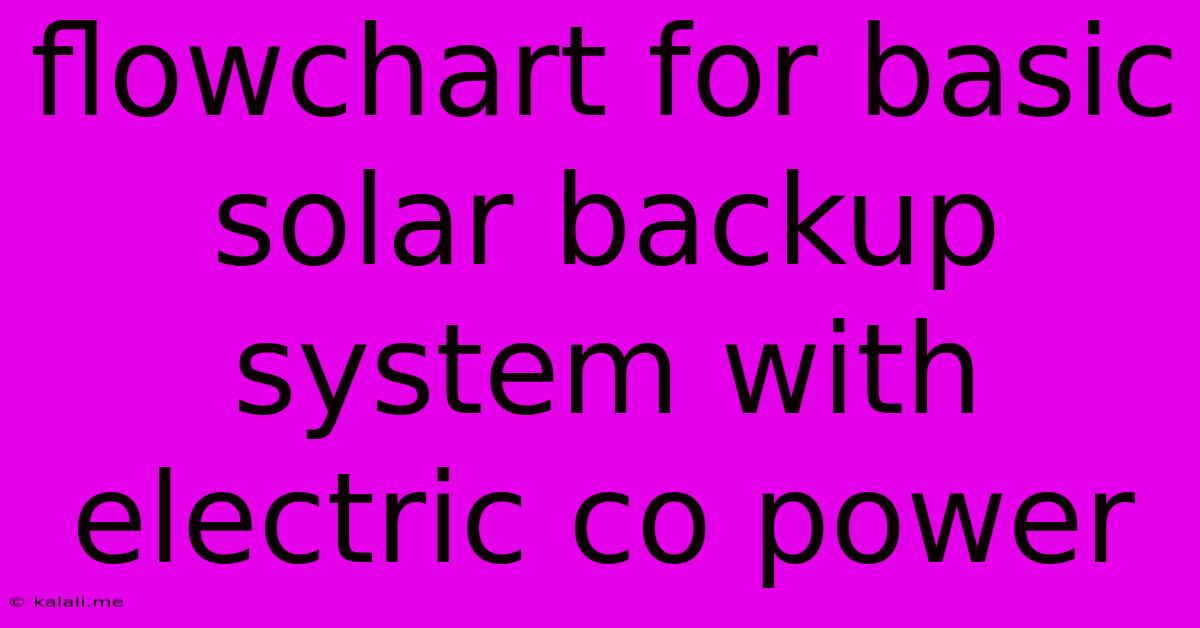Flowchart For Basic Solar Backup System With Electric Co Power
Kalali
May 26, 2025 · 3 min read

Table of Contents
Flowchart for a Basic Solar Backup System with Electric Co-Power
This article details the flowchart for a basic solar backup system that utilizes grid electricity as a backup power source. Understanding this process is crucial for anyone considering installing a solar power system, as it highlights the interplay between solar energy and the traditional electricity grid. This flowchart outlines the system's operation, prioritizing solar energy while seamlessly switching to grid power when necessary. This is essential for ensuring continuous power supply during periods of low sunlight or high energy demand.
System Components
Before diving into the flowchart, let's briefly discuss the key components of a basic solar backup system with grid integration:
- Solar Panels: These convert sunlight into direct current (DC) electricity.
- Charge Controller: Regulates the flow of electricity from the solar panels to the battery bank, preventing overcharging and damage.
- Battery Bank: Stores the DC electricity generated by the solar panels for use during periods of low sunlight or high demand.
- Inverter: Converts the DC electricity from the battery bank into alternating current (AC) electricity, suitable for powering household appliances.
- Grid Tie Inverter (Optional): Allows excess solar energy to be fed back into the electrical grid, potentially earning credits or reducing electricity bills. Also allows grid power to supplement solar power when needed.
- Automatic Transfer Switch (ATS): Automatically switches between solar power, battery power, and grid power based on availability and demand. This is the heart of the system's backup functionality.
- Load: Represents the household appliances and electrical devices consuming power.
Flowchart: Solar Backup System Operation
The following flowchart visually represents the operational logic of a basic solar backup system with grid co-power:
graph TD
A[Sunlight Available?] --> B{Yes};
A --> C{No};
B --> D[Solar Panels Generate DC Power];
D --> E[Charge Controller Regulates Power];
E --> F{Battery Fully Charged?};
F -- Yes --> G[Excess Power to Grid (if applicable)];
F -- No --> H[Power Stored in Battery];
H --> I[Load Requires Power?];
I -- Yes --> J[Power from Battery to Inverter];
J --> K[Inverter Converts to AC];
K --> L[Power to Load];
I -- No --> M[System Standby];
C --> N[Grid Power Available?];
N -- Yes --> O[Power from Grid to Load];
N -- No --> P[System Offline/Error];
G --> I;
O --> I;
Flowchart Explanation
-
Sunlight Available?: The system first checks if sufficient sunlight is available to generate power.
-
Yes: If sunlight is available, solar panels generate DC power.
-
Charge Controller: The charge controller regulates the power flow, preventing overcharging and protecting the battery bank.
-
Battery Fully Charged?: The system checks the battery's charge level.
-
Yes (Excess Power): If the battery is fully charged, excess power can be fed back into the grid (if a grid-tie inverter is installed). This helps optimize energy usage and potentially reduce electricity bills.
-
No (Charging Battery): If the battery is not fully charged, the generated power is stored in the battery bank.
-
Load Requires Power?: The system checks if household appliances or devices are consuming power.
-
Yes (Power from Battery): If power is needed, the battery supplies DC power to the inverter.
-
Inverter: The inverter converts the DC power to AC power suitable for household appliances.
-
Power to Load: AC power is supplied to the household load.
-
No (Standby): If no power is required, the system enters a standby mode, conserving energy.
-
No Sunlight (Grid Power Available?: If no sunlight is available, the system checks if grid power is available.
-
Yes (Power from Grid): If grid power is available, it is supplied to the load.
-
No (System Offline): If neither solar power nor grid power is available, the system enters an offline or error state.
This flowchart provides a clear understanding of how a basic solar backup system with grid co-power functions, ensuring a reliable and efficient power supply even during periods of low sunlight or grid outages. Remember that this is a simplified representation and more complex systems may have additional components and operational steps. Consulting with a qualified solar installer is always recommended before installing any solar power system.
Latest Posts
Latest Posts
-
Why Do British Singers Sound American
May 27, 2025
-
Where Was Jesus When Lazarus Died
May 27, 2025
-
Was Peter In The Bible Married
May 27, 2025
-
Is Momentum Conserved If A Spring Is In The Collision
May 27, 2025
-
How To Shingle A Lean To Shed Roof
May 27, 2025
Related Post
Thank you for visiting our website which covers about Flowchart For Basic Solar Backup System With Electric Co Power . We hope the information provided has been useful to you. Feel free to contact us if you have any questions or need further assistance. See you next time and don't miss to bookmark.